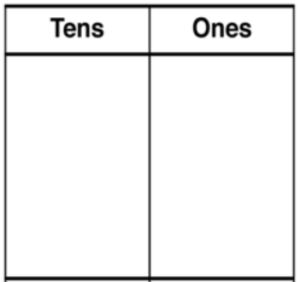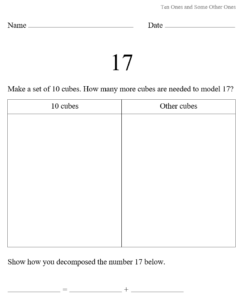MAFS.K.NBT.1.1: Compose and decompose numbers from 11 to 19 into ten ones and some further ones, e.g., by using objects or drawings, and record each composition or decomposition by a drawing or equation (e.g., 18 = 10 + 8); understand that these numbers are composed of ten ones and one, two, three, four, five, six, seven, eight, or nine ones.
Cognitive Complexity Level: 1-Recall
[divider] [/divider] Students are able to…
- Recognize numerals from 0-20.
- Write numerals from 0-20.
- Represent objects with a written numeral 0-20.
- Compose numbers 11-19 using a ten and some ones.
- Decompose numbers 11-19 into a ten and some ones.
- Understand that numbers 11-19 show ten and some ones.
- Connect equations that represent composing or decomposing to physical models and drawings.
[divider] [/divider] Students are able to…because teachers:
- Provide opportunities for students to recognize and write numerals from 0-20.
- Provide part-part-whole mats, number bond mats, tens frames and place value mats for students to compose and decompose numbers 0-20.
Place Value Chart
- Encourage the use of base ten blocks to represent numbers and how to decompose/compose them into a ten and some more ones.
- Represent objects on tens frames to show making 1 ten and counting on by ones to determine the value. (The below model shows a ten and 2 ones, also known as 12.
- Represent numbers 11-19 with equations to show ten and some more ones.
- Encourage students to make connections between the equations and models.
[divider] [/divider] Questions to ask students:
- Ask: How did you decompose 18 into a ten and some ones?
- Sample answer that indicates understanding: I created 18 with a tens rod and 8 ones. I took away and ten and still had 8 ones left. I decomposed 18 into a ten and 8 ones.
- Ask: How can you compose 12 into a ten and some ones.
- Sample answer that indicates understanding: I have a ten, then counted on with ones until I got to 12. It took one ten and 2 ones to compose 12.
- Ask: Can you create a model that shows how you decomposed 15?
- Sample answer that indicates understanding: Students correctly represents 1 tens rod and 5 ones units. Possibly on a place value chart.
- Ask: How does the equation 10+6 relate to your model of 16?
- Sample answer that indicates understanding: The digit 1 in 16 represents one ten. The 6 in 16 represents six ones. So I used one tens rod and six ones.
[divider] [/divider] Additional Resources:
Additional in depth content knowledge
[divider] [/divider] Sample Formative Assessment Tasks:
[divider] [/divider] Resources/Tasks to Support Your Child at Home:
Give your child a set of objects from 11-19, such as straws. Have them group ten objects together and place a rubber band around it. It went from being 10 ones to one ten. When they count the rubber banded group of straws the should say “ten” instead of counting each straw by ones. Have them count on by ones with the other objects to determine how many total objects they have. Ask them, “How many tens did you have? How many ones did you have?” Then extend to record the equation that is represented, such as: 10+6=16.




